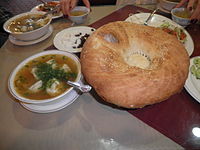

Bukharan Jewish cuisine is the traditional cuisine originating from the Bukharian Jewish community of Central Asia, who now mostly reside in Israel, and the United States.

The cooking of Bukharan Jews forms a distinct cuisine within Uzbekistan, subject to the restrictions of Jewish dietary laws.[1] The most typical Bukharan Jewish dish is oshi sabo (also osh savoorosovoh), a "meal in a pot" slowly cooked overnight and eaten hot for Shabbat lunch. Oshi sabo is made with meat, rice, vegetables, and fruit added for a unique sweet and sour taste.[2] By virtue of its culinary function (a hot Shabbat meal in Jewish homes) and ingredients (rice, meat, vegetables cooked together overnight), oshi sabo is a Bukharan version of cholentorhamin.
In addition to oshi sabo, authentic Bukharian Jewish dishes include the following dishes.[3]
|
| |||||||||||
|---|---|---|---|---|---|---|---|---|---|---|---|
| History |
| ||||||||||
| Types |
| ||||||||||
| Religious dietary laws and related terms |
| ||||||||||
| Chefs |
| ||||||||||
| Religious foods |
| ||||||||||
| Breads |
| ||||||||||
| Sweets |
| ||||||||||
| Pastries |
| ||||||||||
| Fried foods |
| ||||||||||
| Dumplings, pastas and grain dishes |
| ||||||||||
| Casseroles and savory baked dishes |
| ||||||||||
| Snacks and other baked goods |
| ||||||||||
| Sandwiches |
| ||||||||||
| Egg dishes |
| ||||||||||
| Meat dishes |
| ||||||||||
| Fish dishes |
| ||||||||||
| Salads and pickles |
| ||||||||||
| Vegetable dishes |
| ||||||||||
| Soups and stews |
| ||||||||||
| Cheeses and other dairy products |
| ||||||||||
| Condiments, dips and sauces |
| ||||||||||
| Beverages |
| ||||||||||
| Herbs, spices and seasonings |
| ||||||||||
| Related lists |
| ||||||||||
| |||||||||||
|
| |
|---|---|
| History |
|
| Breads |
|
| Salads |
|
| Dips and condiments |
|
| Sandwiches |
|
| Fish |
|
| Soups |
|
| Meat |
|
| Fried foods |
|
| Pasta |
|
| Grains and side dishes |
|
| Desserts |
|
| Alcohol |
|
| Other drinks |
|
| Fruits and vegetables |
|
| Other ingredients |
|
| Cheeses |
|
| Israeli restaurants domestically and abroad |
|